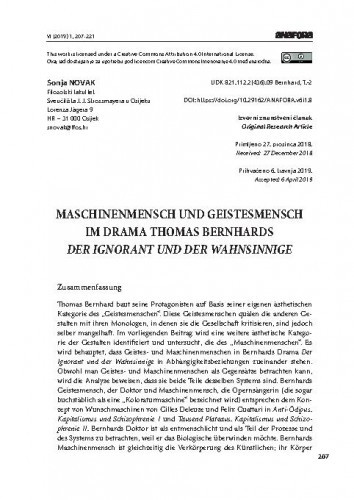Thomas Bernhard baut seine Protagonisten auf Basis seiner eigenen ästhetischen Kategorie des „Geistesmenschen“. Diese Geistesmenschen quälen die anderen Gestalten mit ihren Monologen, in denen sie die Gesellschaft kritisieren, sind jedoch selber mangelhaft. Im vorliegenden Beitrag wird eine weitere ästhetische Kategorie der Gestalten identifiziert und untersucht, die des „Maschinenmenschen“. Es wird behauptet, dass Geistes- und Maschinenmenschen in Bernhards Drama Der Ignorant und der Wahnsinnige in Abhängigkeitsbeziehungen zueinander stehen. Obwohl man Geistes- und Maschinenmenschen als Gegensätze betrachten kann, wird die Analyse beweisen, dass sie beide Teile desselben Systems sind. Bernhards Geistesmensch, der Doktor und Maschinenmensch, die Opernsängerin (die sogar buchstäblich als eine „Koloraturmaschine“ bezeichnet wird) entsprechen dem Konzept von Wunschmaschinen von Gilles Deleuze und Felix Guattari in Anti-Ödipus. Kapitalismus und Schizophrenie 1 und Tausend Plateaus. Kapitalismus und Schizophrenie II. Bernhards Doktor ist als entmenschlicht und als Teil der Prozesse und des Systems zu betrachten, weil er das Biologische überwinden möchte. Bernhards Maschinenmensch ist gleichzeitig die Verkörperung des Künstlichen; ihr Körper ist eine Maschine, deren Aufgabe ist, jeden Abend ihre perfekte Stimme zu produzieren, um der (Kultur-)Industrie ihre Ware immer wieder anbieten zu können. Das Erreichen des „organlosen Körpers“ bedeutet für die beiden ihre Freiheit vom System und eine Rückkehr in die Menschlichkeit.; „Čovjek duha“ Thomasa Bernharda estetska je kategorija na osnovi koje on gradi svoje protagoniste u književnim djelima. Često se radi o tiranima i fanaticima u potrazi za ultimativnom istinom i moći koji u svojim monološkim tiradama kritiziraju svijet i društvo oko sebe, a istodobno nisu ništa bolji od tog istog svijeta i društva; jednako su puni mana. Rad istražuje još jednu vrstu Bernhardovih likova, koji su naizgled sporedni, ali su čvrsto povezani s „ljudima duha“ i u toj su vezi često u podređenom, ovisnom odnosu. Za potrebe ovog rada će ta kategorija biti nazvana ljudi-strojevi. U drami Der Ignorant und der Wahnsinnige Thomasa Bernharda, kao „čovjek duha“ pojavljuje se Doktor, dok se kao čovjek-stroj pojavljuje Operna pjevačica (ona je i doslovno i figurativno opisana kao stroj, „Koloraturmaschine“). Iako po karakteristikama suprotni, ti su likovi u međusobno ovisnom odnosu i dva su lica onoga što Gilles Deleuze i Felix Guattari nazivaju „žudećim strojevima“ u djelu Anti-Edip. Kapitalizam i shizofrenija 1 i Tisuću platoa: kapitalizam i shizofrenija 2. Kao dijelovi iste mašinerije i sustava povezanih i međusobno ovisnih strojeva, svaki od njih na svoj način pokušava ostvariti ono što Deleuze i Guattari nazivaju „tijelo bez organa“ kao kategoriju slobode od sustava i međusobne ovisnosti: Bernhardov intelektualac Doktor tako doslovno tijekom cijele drame drži predavanje o tome kako secirati ljudsko tijelo i kako ukloniti organe jedan po jedan, dok se Operna pjevačica pokušava izbaviti od stroja kojemu služi – kulturne industrije. Dostizanje kategorije „tijela bez organa“ za njih znači slobodu od sustava strojeva i mogućnost povratka u ljudskost.; The so called “Geistesmensch” is Thomas Bernhard's aesthetic basis when creating a protagonist in his literary works. His “Geistesmenschen” [intellectuals] are often fanatic characters in pursuit of the ultimate truth or power and who have tiresome monologues in which they critique the world and the society. Yet they themselves are no better than this world and the society they criticize; they are also full of flaws. This paper examines another kind of Bernhard's protagonists, who are depicted as being in a subordinate, dependent relationship with these “Geistesmenschen” and are described as their opposites. For the purposes of this paper, they will be called “Maschinenmenschen” [human machines or mechanic humans]. In Thomas Bernhard's play Der Ignorant und der Wahnsinnige the character of the Doctor appears as the “Geistesmensch,” while the character of an Opera Singer appears literally and figuratively as a human machine (“Koloraturmaschine”). As opposite characters entangled in a co-dependent relationship, they represent what Gilles Deleuze and Felix Guattari call a system of “desiring machines” as described in their work Anti-Ödpius: Capitalism and Schizophrenia 1 and A Thousand Plateuas: Capitalism and Schizophrenia 2. As parts of the same machinery, they strive towards achieving what Deleuze and Guattari call “a body without organs” which represents a kind of freedom from their dependency on each other and the system: Bernhard's intellectual, the Doctor, describes throughout the play how to dissect the human body and in his monologues depicts very vividly how to remove its organs, while the human machine, the Opera Singer, is trying to pry herself loose from the machinery of the cultural industry she is a part of. Achieving a “body without organs” would for them mean freedom from the system of entangled machines and the possibility to become human again.
Sažetak

 Anafora : časopis za znanost o književnosti = [academic literary journal] : 6,1(2019) / glavni i odgovorni urednik, editor-in-chief Ružica Pšihistal.
Anafora : časopis za znanost o književnosti = [academic literary journal] : 6,1(2019) / glavni i odgovorni urednik, editor-in-chief Ružica Pšihistal.